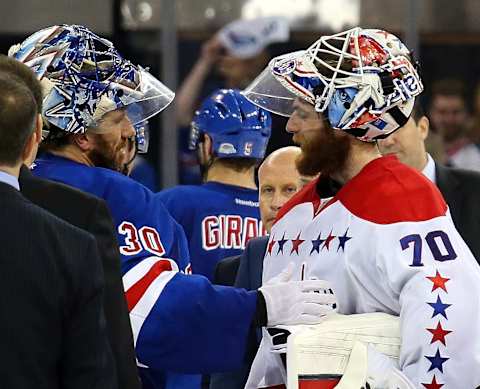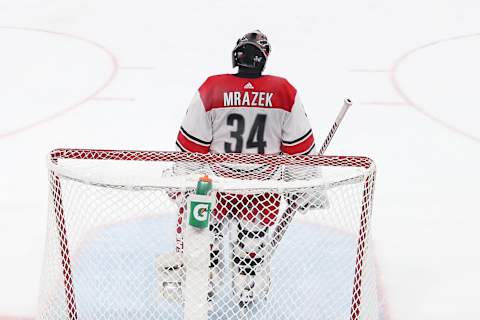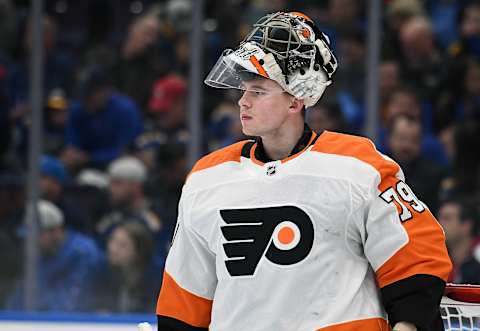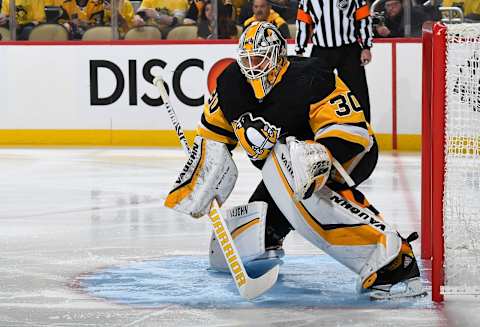Metropolitan Division: Ranking the goaltending for each team


In what should be a competitive Metropolitan Division, goaltending could be the difference maker.
Growing up a New Jersey Devils fan, I was treated to watching amazing goaltending. The best goaltender the sport of hockey has ever seen in Martin Brodeur lead the Devils for their glory years with his acrobatic heroics. The goaltending of the Metropolitan Division has changed a lot since Martin Brodeur hung up his skates for the last time.
The highlights didn’t belong to only the Devils. There was the 2001 Stanley Cup final where Brodeur faced off against his idol Patrick Roy of the Colorado Avalanche in a losing effort. In 2009 then Carolina Hurricanes goaltender Cam Ward would emerge victorious over Brodeur.
More from Puck Prose
- Detroit Red Wings 2023 Rookie Camp Has Plenty of Ups and Downs
- This Columbus Blue Jackets rookie doesn’t want to be forgotten
- 2 trades the Boston Bruins must make to secure the Stanley Cup
- 3 reasons the Avalanche won’t win the Stanley Cup in 2024
- This is a big year for Alex Turcotte and the Los Angeles Kings
And then there was the player that Devils fans love to hate – Henrik Lundqvist of the New York Rangers. Whenever the Devils and Rangers would face-off, all eyes were glued to the opposing ends of the ice as the two goaltenders would duel throughout the night.
The Metro figures to be one of the most competitive divisions in the NHL next season. There’s not much of a dropoff between the best team and the worst. Goaltending can be the ultimate equalizer.
So it wouldn’t be surprising if goaltending wound up deciding who makes the playoffs out of the Metropolitan Division and who doesn’t.
These rankings are purely based on projected number one and two goaltenders for the next season, with prospects not taken into account.
Now, as we enter the next season, let’s look at goaltending throughout the Metropolitan Division.

The Bottom Tier
8. Columbus Blue Jackets
Summer was not kind to the city of Columbus, as all their big-name free agents sought employment elsewhere. One of those players leaving the Columbus cannon behind was goaltender Sergei Bobrovsky, arguably the most beloved and successful goaltender to ever play for the franchise.
Bobrovsky’s arrival was what turned the Blue Jackets from one of the NHL’s bottom dwellers to a team that could at least make the playoffs. His departure is going to hurt this coming season.
Although the Blue Jackets firmly believe that Bobrovsky’s backup in Joonas Korpisalo can serve as his successor, his GAA remains dangerously close to 3.00 (it stood at 2.95 last season). Also, his save percentage has been under .900 by the hair the past two-year.
Both those stats prove him and first-year backup Elvis Merzlinkins will have trouble filling Bobrovsky’s shoes.
7. Carolina Hurricanes
It’s surprising to rank the Hurricanes this low after their impressive season and run to the Eastern Conference final. The Hurricanes had incredible success dividing their starts the past season between Petr Mrazek and Curtis McElhinney.
McElhinney left to sign a deal with the Tampa Bay Lightning, while Mrazek signed a new contact cementing his number one status. Mrazek had a great bounce-back year in Carolina, but it’s hard to place full confidence in him considering how his career seemingly bottomed out with the Philadelphia Flyers.
If Mrazek plays like 2018-2019 Mrazek or even Detroit Red Wings era Mrazek, Carolina will be fine. Part of their low ranking is their projected backup, James Reimer. Reimer isn’t terrible by any stretch of the imagination, but he didn’t necessarily have a good year with the Florida Panthers last year as well. He’ll make a fine backup, but if anything happens to Mrazek that pushes him into service, you better hope he channels a McElhinney type run in him.

The Uncertain Middle
The Philadelphia Flyers have seemed to find their goaltender of the future in Carter Hart. If he lives up the hype, he’ll be everything that Flyers fans want and more. The Flyers also went all-in on Hart at the deadline by trading for his mentor, Cam Talbot, from the Edmonton Oilers.
This reunion between the two on the Flyers roster was short-lived as Talbot signed in Calgary this past off-season. Why are the Flyers ranked so low? Hart still remains relatively unproven. By no means is this saying that Hart is going to be a bad goaltender, but at the current moment, it’s hard to rank him until we see more of him. Hart’s back up in Brian Elliott is a good insurance policy, but you have to ask how effective Elliott would be, even in a backup role, at age 34.
5. New Jersey Devils
Maybe the Devils are ranked higher than they should in this category, but there’s a reason behind this. Last season, goaltending prospect Mackenzie Blackwood was called up to the NHL and gave Devils fans a lone bright spot in a terribly forgettable season that saw them finish last in the division a year removed from a playoff spot.
It might be too soon to call him the next Brodeur, but Blackwood posted a respectable goals against average of 2.61 and a save percentage of 0.918% in his first year. With youth on his side, and the confidence of the Devils coaching staff, it seems the only way to go is up for Blackwood.
Then there’s the matter on Jersey’s other goaltender – Cory Schneider. Once considered an elite goalie, years of injuries, a winless streak that spanned two seasons and declining stats have relegated me to the number two overall role.
With that issue since corrected, since coming back from surgery last season, Schneider has begun showing some flashes of his old self. His win-loss record was still seven games under .500, so he’ll obviously never be the goaltender that New Jersey traded their ninth overall pick in 2013 for again. If he can continue to return to form, it’ll be a pleasant surprise for the Devils. That reason is why they’re ranked just a hair above their rivals from the City of Brotherly Love.

The Good
It was the New York Islanders stellar goaltending duo of Robin Lehner and Thomas Greiss that got them into the playoffs, and an eventual sweep of their first-round opponent, the Pittsburgh Penguins.
Unfortunately for the islanders, the better of those two goaltenders (Lehner) left to sign a contract with the Chicago Blackhawks. Losing him in the year he and Greiss won the Jennings Trophy will be a hard blow.
Lehner’s subsequent replacement in Semyon Varlamov is a disappointing downgrade, although he might be suited well as a backup with a lighter load after starting 49 games last season. Greiss finished last season with an amazing goals against average of 2.28 and a 0.927 save percentage. Still, his numbers from a season before with a 3.82 goals against average and 0.892 save percentage should cause some concern.
Matt Murray may be a two-time Stanley Cup champion, but he’s also the face of inconsistency. During any stretch of the season, you can see the 2016 and 2017 Stanley Cup playoff version of Murray, or you can see the Murray who gets benched for the likes of Casey DeSmith.
When he’s playing well, the Penguins look like the threat we’ve come to know them as. But when Murray’ss off, we find ourselves wondering how close the Penguins will get to missing the playoffs.
Speaking of DeSmith, the Penguins have one of, if not the best, backup goaltenders in the division. He proved last season he can answer the call of duty as a number one when he started 36 games for the Penguins.
DeSmith’s stats slightly dipped from his first season in 2017-2018, but his workload also increased exponentially over that time frame as well. Luckily for Pittsburgh, the Penguins always seem to come through in the end, so this should be an area of much worry.

The Best Of The Pack
Goaltending prospect Igor Shestyorkin has been signed from the KHL. Still, in his first North American season, he’s more likely to spend time in the minors, leaving Henrik Lundqvist and Alexandar Georgiev as the projected number one and number two.
Georgiev is a lot like DeSmith, in the fact that although he’s regarded as the backup, he can take the reins of a start with ease when called upon. Lundqvist is the victim of decreasing stats as he continues facing father time.
Still, the argument could be made that Lundqvist at age 37 is better than most goaltenders will be during their entire careers. Although age is not on his side, he’s still the face of New York hockey and rises to the occasion when needed. If there’s one unfortunate lesson I’ve learned as a New Jersey Devils fan, it’s to never underestimate Lundquist.
Even though they were bounced in the first round, a game seven match up against an overachieving Carolina Hurricanes quad, the Washington Capitals are the team to beat in the Metro. A large part of their success falls upon their goaltender Braden Holtby.
The 6’2” workhouse is still on the right side of 30 years old and should dominate the Capitals crease for years to come. He finished his first post-championship season with a 2.82 goals against average and .911 save percentage.
Next. 3 Burning Questions For The Capitals. dark
Backup Pheonix Copley proved highly effective in his first year with a major NHL workload and gives the Capitals a great chance to win on Holtby’s nights off. After Bobrovsky’s departure to Florida, Holtby is the undisputed best goaltender in the Metropolitan Division. Why? Go on YouTube and search “Braden Holtby saves game with miraculous stop” and watch it. Then watch it again. And again. Any questions? I think not.